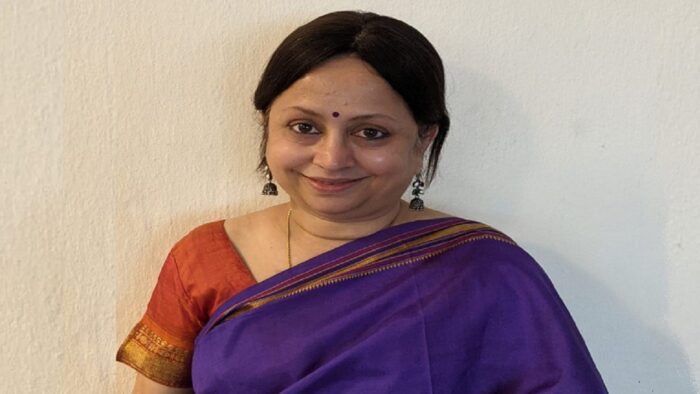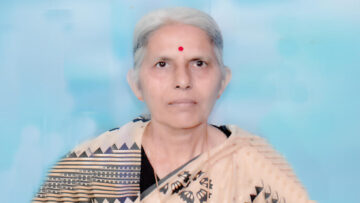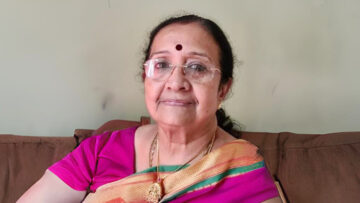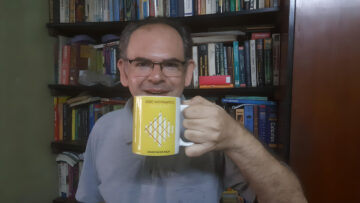Dr. Siri Rama, a Bharatanatyam and Kuchipudi dancer, choreographer , researcher and lecturer, has immersed herself in the expression of bhakti through dance. Through the Kanaka Sabha Performing Arts Centre in Mumbai, she has spread the teachings of her gurus and her own unique style to hundreds of students. Through her international collaborations in Singapore and Hong Kong she has shown how Indian dance forms have a universal resonance. She presented a paper at Indica’s Vaishnavism Conference at Srirangam where she spoke on the “Maya and Lila of Lord Vishnu’s Dance.” In this interview, she outlines the many threads connecting Vaishnavism to Indian dance.
The most obvious cosmic references to Indian classical dance is to the dance of Nataraja. However, in the same light we have Kuchipudi which developed as a Krishna-related Vaishnavite dance and is also known as Bhagavata Mela in Thanjavur. While having roots in the Natyashastra, what were the main influences on this form of dance?
Though the earliest extant text on the Natyashastra attributes the origin of dance to Lord Shiva, later texts of the medieval period attribute the origin of dance to Lord Vishnu . For example, this is clearly seen in Nartananirnaya a 16th century Sanskrit text which is dedicated to the nartaka and his/her ensemble of musicians. This treatise is written by Pandarika Vitthala who was smartha Vaishnava brahmin and who was devotee of Vitthala of Pandarpura. Nartananirnaya departs from the usual practice of crediting Shiva with the origin of dance. Vishnu is said to create dance by the mere movement of his eyebrows, which makes the danseuse Maya, dance. Lakshmipati or Vishnu is said to make Maya dance in the form of his incarnations Vamana and Narasimha. Everybody bows down to Maya and her lord Vishnu who enact the play of the whole world. Krishna is also invoked for his blessings. He is described as being immersed in sport of the rasa dance (Nartananirnaya (Vol I), Chap I, sl 1-2). The shloka is as follows
मङ्गलाचरणम्
श्रीलक्ष्मीपतिचित्तवैभवसकृभ्रूक्षेपसंज्ञाज्ञया
विश्वाकारवती महागुणवती मायानटी नृत्यति ।
तां को नर्तयतीह वामननृसिंहादिस्वरूपैरलं
तौ वन्देऽखिललोकनाटकमयौ मायां च मायापतिम्
ईशं यतिलयोपेतं वर्णभेदैरुपाश्रितम् ।
रासक्रीडामयं नत्वा वक्ष्ये नर्तननिर्णयम् ॥
maṅgalācaraṇam
śrīlakṣmīpaticittavaibhavasakṛbhrūkṣepasaṃjñājñayā
viśvākāravatī mahāguṇavatī māyānaṭī nṛtyati ।
tāṃ ko nartayatīha vāmananṛsiṃhādisvarūpairalaṃ
tau vande’khilalokanāṭakamayau māyāṃ ca māyāpatim
īśaṃ yatilayopetaṃ varṇabhedairupāśritam ।
rāsakrīḍāmayaṃ natvā vakṣye nartananirṇayam ॥
The author in this text offers his salutations to Mayapati or Vishnu who is responsible for the enactment or drama of the entire world. I have written a book called ‘Dance Divine: Dancing Deities of India’ (2021), Shubhi Publications (New Delhi, India) in which I have dedicated an entire chapter to the dance of Vishnu in dance texts, performances and temple sculptures.
Regarding Kuchipudi, in the 16th century Swami Siddhendra Yogi had a great influence on the development of the Kuchipudi dance drama tradition. From existing historical records and research by scholars one can see that there was an established tradition of presenting stories from the Bhagavata Purana and other local legends about Lord Krishna in the medieval period. Satyabhama was eulogised by many Telugu writers and being a queen consort of Lord Krishna, her story was presented by the poets in all her multifaceted glory, especially between the 15th and 16th centuries. The Mahabharata of Nannayya (11th c), Leela Suka’s Krishnakarnamrutam (13thc) , Errana’s Harivamsham (14th c), Nachana Somana’s Uttara Harivamsham (14th c), Potana’s Bhagavatam (15th c ), Nandi Timanna’s Parijatapaharanam (15th c) all eulogise Satyabhama. Satyabhama is seen as the most beloved queen of Krishna, who unlike other queens even rides with him to battle to get the Parijata tree. She is described as one who ties her sari and gets battle ready with a bow and arrow, striking fear in the minds of the enemy, Narakasura. She is also described as somebody who is beset by common human emotions such as jealousy, anger and is ready to fight with her husband Lord Krishna.
Thus, Satyabhama resided in the minds of the poets and artists as somebody who not only had all the qualities of an uttama nayika but also the very human reactions which made her relatable to all. Into this historical legacy of poetry or kavya literature and performance traditions, Yati Narayana Teertha came with his Parijataapaharanamyakshaganam in the 16th c, for the Melattur Bhagavataha mela performers. Yati Narayana Teertha had already written his magnum opus Sri Krishna Leela Tarangini which is performed even to this day. In Parjataapaharanam, the story unfolds with Satyabhama feeling deep sorrow on Krishna being away from her, and disappointment about Krishna giving the coveted celestial flower Parijata to Rukmini. Eventually Krishna tries to console her and they both set out to get the entire Parijata tree and the drama ends in praise of Lord Krishna by Indra.
Siddhendra Yogi wrote Bhama Kalapam for the Kuchipudi performers to present the story of Krishna and Satyabhama in a version that advocated his philosophies. His remains the main influence as accepted by scholars today in what constitute the important elements of Kuchipudi.
When we say that a dance is Shaivite based or Vaishnavite based, are we talking only about the content, or is there a large philosophical and aesthetic distinction? Almost all our dance forms such as Kathak which often recounts childhood and adult episodes of Krishna, Kuchipudi, Odissi focusing on Krishna as Jagannath, Sattriya (the Krishna focussed monasteries of Assam), Mohiniyattam, the seductress avatar of Vishnu are based on Vaishnavite traditions.
I would begin here by the example of the classical dance of Mohiniattam from Kerala which traces its origin to the Mohini rupa of Lord Vishnu. Scholars like Kavalam Narayana Pannicker and Dr (Smt) Kanak Rele have done a lot of research on the subject of Mohinattam technique or movements . They have proven beyond doubt that the movements of the dance style are based on Vaishnavite philosophies.
My own research and experience in the classical dance styles points to the fact that styles which were influenced by Vaishnavite philosophers and performers tended to have circular movements. Obvious examples in folk dance are the raas garba dance of Gujarat or even the warkari tradition of Maharashtra which has dance sankirtan practise which is called ringan or forming a circle. In the paper presented at the Indica conference on Vaishnavism at Srirangam, I have presented similar constructs for the dance style of Kuchipudi. The abstract dance movements or nritta tends to be circular as it was influenced by Vaishnava sampradaya. The circularity of movement is due to influence of philosophical traditions and also through movement, many social constructs that can be expressed in a circular formation. A very obvious and simple example would be, if people stand in a circle there is no hierarchy. This is very evident in a lot of Vaishnava saint poet compositions, where the lyrics by the saint poet reflect that both the king and the labourer are the same. This is also reflected in dance through movements.
In the Rasa Lila and Sankirtan dance traditions of Manipur, we see the life of Krishna being the main theme of the dance. While the former involved only women, the latter men. And both are performed on certain special days. Is this unique to this region or does the whole of India have similar traditions of dance related to the worship of Vishnu?
We have the warkari tradition of Maharashtra which though not strictly a dance tradition consists of singing and dancing in devotional ecstasy. The Bhagavata mela tradition of Mellatur has special performances on Narasimha Jayanthi. There are many such examples in different parts of India.
How have Vaishnava works influenced temple worship in India? Taking Bhakti as the most prevailing rasa, Shringara is also stressed. The rendering of Ashtapadis in the temples of Kerala has been a tradition for several centuries. It is sung in Guruvayur in a style called sopana sangeetha. Is this the case elsewhere too?
As is well known, the Madhura bhakti movement swept India in the medieval period and movements like raganuga bhakti sadhana philosophy influenced temple worship. Saint poets like Jayadeva wrote the asthapadis which were used for worship and are sung to this day in the Puri Jaganatha temple. Besides asthapadis the songs of saint poet Annamacharya and saint poetess Meerabai have also been sung in temples as a form of worship. There are many such examples of Vaishnavite influence on temple worship traditions. For example the devadasi in a Vishnu temple in ancient days would be called Garuda dasi, these dancers were dedicated to the Garuda stambha in front of the temple.
What appeals to you most about the lila of the Lord? What is the most beautiful thing about losing oneself in his love?
Devotion is a very personal experience for me as I understand through Indic traditions and is difficult to express in words or even share it with the rest of the world. I best express my love for this universal divinity through my dance and my passion for seeking the truth and understanding the world and my heritage through my dance.
You connect Physics to Dance in one of your Ted Talks. How do you compare the two?
My talk on the Physics of Indian dance came through my personal love for the science of Physics (I studied it at a post graduate level), and my love for Indian dance. I have also presented papers in conferences where I have talked about the Indic Gurukula system of teaching which can be compared to the reflection, absorption and refraction of light in Physics. In my TEDx talk I have talked about two aspects – the first one is the comparison of Nataraja’s cosmic dance to certain particle Physics discoveries which have been talked about by other scholars too. The second aspect is in understanding the mechanical physics of Indian dance and thereby understanding why certain dance styles have movements which cover more space or some styles have smaller movements or why certain styles have more leaps and how they are accomplished in terms of defying gravity etc.
Watch the video of Dr. Siri Rama at the Vaishnavism Conference, INDICA
Disclaimer: The opinions expressed in this article belong to the author. Indic Today is neither responsible nor liable for the accuracy, completeness, suitability, or validity of any information in the article.








